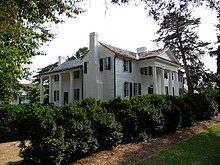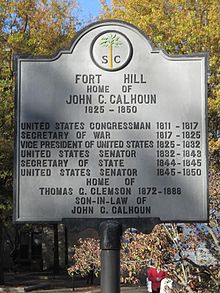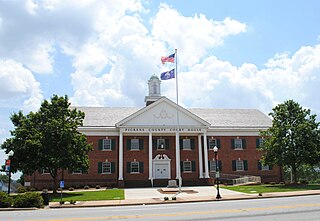
Pickens County is a county located in the northwest part of the U.S. state of South Carolina. As of the 2020 census, its population was 131,404. Its county seat is Pickens. The county was created in 1826. It is part of the Greenville-Anderson-Greer, SC Metropolitan Statistical Area.
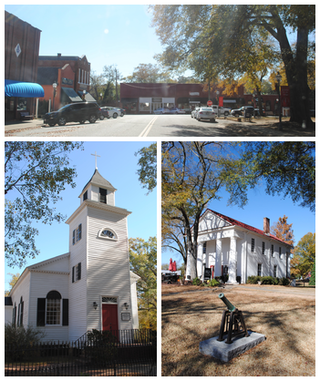
Pendleton is a town in Anderson County, South Carolina, United States. The population was 3,489 at the 2020 census. It is a sister city of Stornoway in the Outer Hebrides of Scotland.

Clemson is a city in Pickens and Anderson counties in the U.S. state of South Carolina. Clemson is adjacent to Clemson University, and is identified with it; in 2015, the Princeton Review cited the town of Clemson as ranking #1 in the United States for "town-and-gown" relations with its resident university. The population of the city was 17,681 at the 2020 census.

Andrew Pickens Jr. was an American soldier and politician. He served as the 46th Governor of South Carolina from 1816 until 1818.
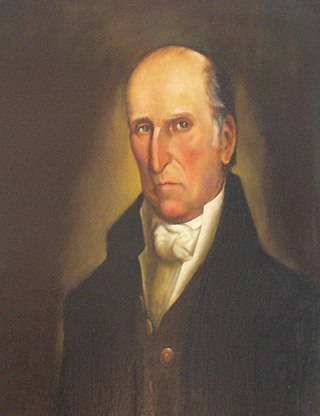
Andrew Pickens was a militia leader in the American Revolution. A planter and slaveowner, he developed his Hopewell plantation on the east side of the Keowee River across from the Cherokee town of Isunigu (Seneca) in western South Carolina. He was elected as a member of the United States House of Representatives from western South Carolina. Several treaties with the Cherokee were negotiated and signed at his plantation of Hopewell.

Brookgreen Gardens is a sculpture garden and wildlife preserve, located just south of Murrells Inlet, in the U.S. state of South Carolina. The 9,100-acre (37 km2) property includes several themed gardens featuring American figurative sculptures, the Lowcountry Zoo, and trails through several ecosystems in nature reserves on the property. It was founded by Archer Milton Huntington, stepson of railroad magnate Collis Potter Huntington, and Anna Hyatt Huntington, his wife, to feature sculptures by Anna and her sister Harriet Randolph Hyatt Mayor, along with other American sculptors. Brookgreen Gardens was opened in 1932. It was developed on property of four former rice plantations, taking its name from the former Brookgreen Plantation, which dates to the antebellum period.
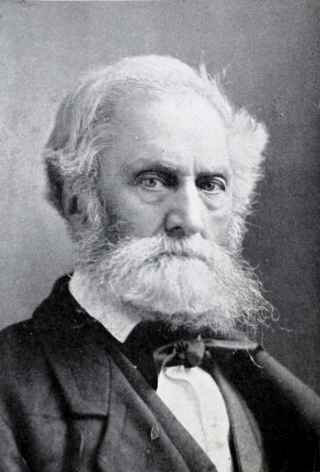
Thomas Green Clemson was an American politician and statesman, serving as Chargés d'Affaires to Belgium, and United States Superintendent of Agriculture. He served in the Confederate Army and founded Clemson University in South Carolina. Historians have called Clemson "a quintessential nineteenth-century Renaissance man." He was an owner of enslaved persons.

The Calhoun Mine is perhaps the oldest and best-known mine in Lumpkin County, Georgia. When gold was discovered in Lumpkin County in 1828, which led to the Georgia Gold Rush in 1829, it was discovered on 239 acres (0.97 km2) owned by Robert Obar. After at least two intermediary sales, the land was purchased by Senator John C. Calhoun of South Carolina, who later served as the 7th Vice President of the United States. Calhoun started a mining company to mine the land and later allowed his son-in-law Thomas Green Clemson, the founder of Clemson University, to manage it. The ore deposit was a very rich deposit and, according to an 1856 letter from Clemson to his brother-in-law, was still producing significant quantities of gold nearly 30 years after its initial discovery on the land. This mine - along with the Consolidated Mine and the Loud Mine - were some of the most productive mines in the Georgia Gold Belt.
The Cherokee Path was the primary route of English and Scots traders from Charleston to Columbia, South Carolina in Colonial America. It was the way they reached Cherokee towns and territories along the upper Keowee River and its tributaries. In its lower section it was known as the Savannah River. They referred to these towns along the Keowee and Tugaloo rivers as the Lower Towns, in contrast to the Middle Towns in Western North Carolina and the Overhill Towns in present-day southeastern Tennessee west of the Appalachian Mountains.

The Charles Pinckney National Historic Site is a unit of the United States National Park Service, preserving a portion of Charles Pinckney's Snee Farm plantation and country retreat. The site is located at 1254 Long Point Road, Mount Pleasant, South Carolina. Pinckney (1757-1824) was a member of a prominent political family in South Carolina. He fought in the American Revolutionary War, was held for a period as prisoner in the North, and returned to the state in 1783. Pinckney, a Founding Father of the United States, served as a delegate to the constitutional convention where he contributed to drafting the United States Constitution.

Floride Bonneau Calhoun was the wife of U.S. politician John C. Calhoun. She was known for her leading role in the Petticoat affair, which occurred during her husband's service as vice president of the United States. In that role, Mrs. Calhoun led the wives of other Cabinet members in ostracizing Peggy Eaton, the wife of Secretary of War John Eaton, whom they considered a woman of low morals. The affair helped damage relations between John C. Calhoun and President Andrew Jackson, and effectively ended any legitimate chance of John Calhoun becoming president of the United States.

John Ewing Colhoun was a United States Senator and lawyer from South Carolina.

Old Stone Church is a church building built in 1802. When it was constructed, it was in the Pendleton District, South Carolina. When Pendleton District was divided in 1826, the church was in Pickens District. When Pickens District was split in 1868, it was in Oconee County, South Carolina. In 1968, this section of Oconee County was annexed back to Pickens County. The church is about midway between the centers of Pendleton and Clemson. It is now in the city limits of Clemson.

Hanover House is a colonial house built by a French Huguenot family in 1714–1716, on the upper Cooper River in present-day Berkeley County of the South Carolina Low Country. The house is also known as the St. Julien-Ravenel House after its early owners.

Mulberry Plantation, also known as the James and Mary Boykin Chesnut House is a historic plantation at 559 Sumter Highway south of Camden, South Carolina. Declared a National Historic Landmark in 2000, it is significant as the home of American Civil War chronicler Mary Boykin Chesnut, who produced some of the most important written accounts of the war from a Confederate perspective. The main house, built about 1820, is a fine example of Federal period architecture.
The Campus of Clemson University is located in unincorporated Pickens County, South Carolina, adjacent to Clemson; the U.S. Census Bureau designates the campus as a census-designated place.

Anna Maria Calhoun Clemson was the daughter of John C. Calhoun and Floride Calhoun, and the wife of Thomas Green Clemson, the founder of Clemson University.
Ezekiel Pickens was an American lawyer and politician; he served as the Lieutenant Governor of South Carolina from 1802 to 1804.
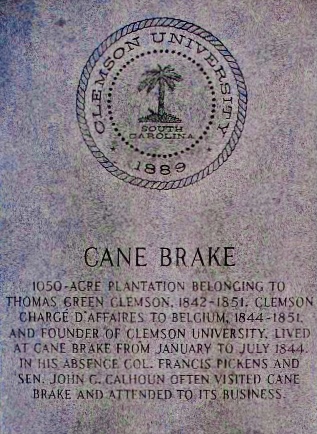
Cane Brake was a plantation home in Saluda, South Carolina, an historic property of Thomas Green Clemson of Philadelphia, Pennsylvania, after whom Clemson University is named.



